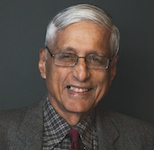Rajmohan Gandhi writes on textbook deletions: You can’t delete Gandhi’s truth
At its core, is the clarity that India belongs to all who live in it. This core displays two other messages. One is Ishwar Allah Tere Naam. The other is that feeling the Other’s pain, knowing the paraayi’s peeda, is the mark of a good individual
History students in Class 12 will no longer be informed that Gandhi’s assassin Nathuram Godse was “a Brahmin from Pune” or that as “the editor of an extremist Hindu newspaper” Godse had “denounced Gandhiji as ‘an appeaser of Muslims’”, writes Rajmohan Gandhi. (Express Archives)
A few are still alive, and I am one of them, who remember the prayer meetings that Mahatma Gandhi held in New Delhi during the 1947-48 winter on the lawns of Birla House on what then was called Albuquerque Road and is now Tees January Marg.
Twelve at that time, I often took part in those prayer meetings, but a sports event in my school detained me on the afternoon of January 30, 1948, preventing me from being near my grandfather when he was assassinated while walking to the prayer spot.
Those 1947-48 days return to my mind as I try to absorb The Indian Express story of Wednesday April 5 on the latest deletions in NCERT textbooks. It seems that sentences that class 12 political science students across India read for the past 15 years or more but will no longer see include the following:
He (Gandhi) was particularly disliked by those who wanted Hindus to take revenge or who wanted India to become a country for the Hindus, just as Pakistan was for Muslims…
His steadfast pursuit of Hindu-Muslim unity provoked Hindu extremists so much that they made several attempts to assassinate Gandhiji…
Gandhiji’s death had an almost magical effect on the communal situation in the country… The Government of India cracked down on organisations that were spreading communal hatred.
Also, history students in Class 12 will no longer be informed that Gandhi’s assassin Nathuram Godse was “a Brahmin from Pune” or that as “the editor of an extremist Hindu newspaper” Godse had “denounced Gandhiji as ‘an appeaser of Muslims’”. These and other deletions will “reduce curriculum overload” and “rationalise content”, it has been claimed.
I cannot accept such claims. I see the deletions as part of an ongoing process of piece-by-piece obliteration that aims, finally, to remove all evidence that Gandhi was killed because of his insistence that India belongs to all who live in it, including Muslims and Christians, and not just to Hindus.
However, this removal of evidence is an unattainable goal. Killing Gandhi was the easy part. Killing the thought that India belongs to everyone, killing the historical truth that Gandhi underlined that thought, and killing the connected historical truth that Gandhi was murdered above all for that underlining — those are impossible exercises.
Physically, it would not be impossible — if we came to that pass — to close down Gandhi Smriti on Tees January Marg. Reducing “traffic overload” can be cited as a reason. However, destroying India’s or the world’s knowledge of what happened on Tees January is beyond the capacity of any governmental agency or, indeed, of any state, no matter how powerful.
Can censors or agencies eliminate the record, in sound and text, of what Jawaharlal Nehru and Vallabhbhai Patel said on All India Radio on that night of January 30, 1948? Will the records of the hundreds of newspapers that were printed across India on January 31 all disappear? Some of those pages are now on microfilm too and accessible across the world.
And since America is where millions of Indians now live, we can also look at what an American whom the world loves said about why Gandhi was killed. Speaking in his church in Montgomery, Alabama, this is what Martin Luther King Jr said on March 22, 1959, shortly after returning from his first and last visit to India:
“They killed him, this man who had galvanised 400 million [Indians] for independence… One of his own fellow Hindus felt that he was a little too favourable toward the Moslems… Here was a man of love falling at the hands of a man with hate… But the man who shot Gandhi only shot him into the hearts of humanity.” (The Papers of Martin Luther King, Jr., University of California Press, vol. 5, p. 156.)
To repeat, killing Gandhi the man was the easy part. But there’s also Gandhi the thought, or Gandhi the idea. At its core, as we have noted, is the clarity that India belongs to all who live in it. This core displays two other messages. One is Ishwar Allah Tere Naam. The other is that feeling the Other’s pain, knowing the paraayi’s peeda, is the mark of a good individual.
How easy will it be to censor, banish, or destroy these thoughts which were closer to Gandhi than his hands or feet, and which, moreover, are thoughts shared by crores of Indians? It is but natural, nonetheless, for the people of India to be deeply concerned at the textbook deletions, which suggest a lack of comfort with the truth.
One deletion that does not agitate me is about Godse being a Brahmin. Godse didn’t do what he did because he was a Brahmin. His dislike, not his Brahminhood, motivated him. Another Brahmin, also from Maharashtra, a remarkable man called Vinoba Bhave, was not only one of Gandhi’s closest friends and associates. Bhave inspired thousands across India to share their lands with the landless.
Two months after Gandhi was killed, Vinoba Bhave told a gathering of Gandhi’s associates in Sevagram that the group that had nurtured the Mahatma’s assassin was “fascist in character”. (Gandhi is Gone, Report of 1948 Sevagram Conclave, Permanent Black, 2007, p. 89).
The textbook deletions, 75 years later, are a sign of our times.
